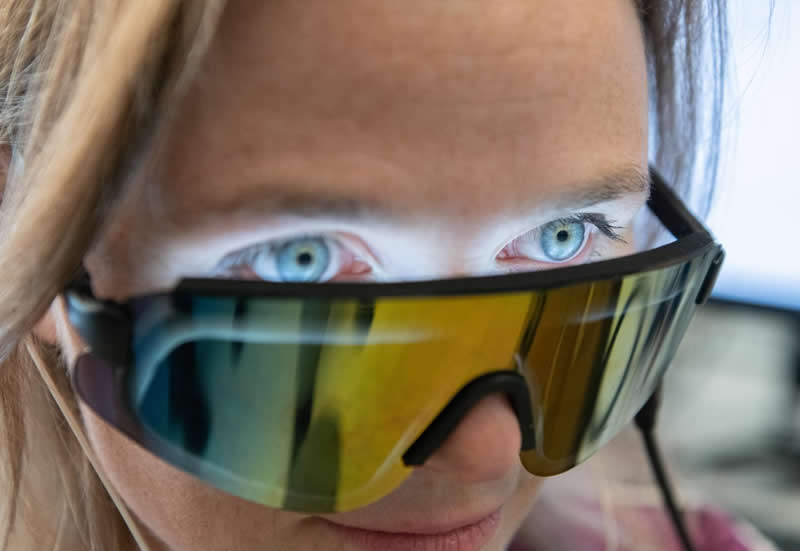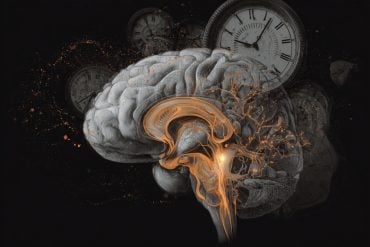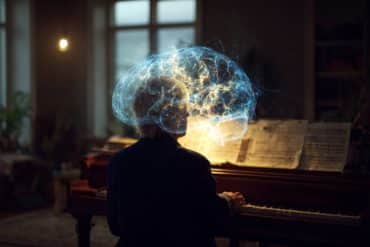Summary: Exposure to light pulsing at 40 hertz causes the brain to release a surge of cytokines which activate microglia and reduces neuroinflammation. The findings could help with the development of new treatments to fight Alzheimer’s disease.
Source: Georgia Institute of Technology
For over a century, Alzheimer’s disease has confounded all attempts to treat it. But in recent years, perplexing experiments using flickering light have shown promise.
Now, researchers have tapped into how the flicker may work. They discovered in the lab that the exposure to light pulsing at 40 hertz – 40 beats per second – causes brains to release a surge of signaling chemicals that may help fight the disease.
Though conducted on healthy mice, this new study is directly connected to human trials, in which Alzheimer’s patients are exposed to 40 Hz light and sound. Insights gained in mice at the Georgia Institute of Technology are informing the human trials in collaboration with Emory University.
“I’ll be running samples from mice in the lab, and around the same time, a colleague will be doing a strikingly similar analysis on patient fluid samples,” said Kristie Garza, the study’s first author. Garza is a graduate research assistant in the lab of Annabelle Singer at Georgia Tech and also a member of Emory’s neuroscience program.
One of the surging signaling molecules, in particular, is associated with the activation of brain immune cells called microglia, which purge an Alzheimer’s hallmark – amyloid beta plaque, junk protein that accumulates between brain cells.
Immune signaling
In 2016, researchers discovered that light flickering at 40 Hz mobilized microglia in mice afflicted with Alzheimer’s to clean up that junk. The new study looked for brain chemistry that connects the flicker with microglial and other immune activation in mice and exposed a surge of 20 cytokines – small proteins secreted externally by cells and which signal to other cells. Accompanying the cytokine release, internal cell chemistry – the activation of proteins by phosphate groups – left behind a strong calling card.
“The phosphoproteins showed up first. It looked as though they were leading, and our hypothesis is that they triggered the release of the cytokines,” said Singer, who co-led the new study and is an assistant professor in the Wallace H. Coulter Department of Biomedical Engineering at Georgia Tech and Emory.
“Beyond cytokines that may be signaling to microglia, a number of factors that we identified have the potential to support neural health,” said Levi Wood, who co-led the study with Singer and is an assistant professor in Georgia Tech’s George W. Woodruff School of Mechanical Engineering.
The team publishes its findings in the Journal of Neuroscience on February 5, 2020. (There is no embargo. Pre-publication appeared in December but did not yet contain all edits and elements.) The research was funded by the National Institute of Neurological Disorders and Stroke at the National Institutes of Health, and by the Packard Foundation.
Singer was co-first author on the original 2016 study at the Massachusetts Institute of Technology, in which the therapeutic effects of 40 Hz were first discovered in mice.
Sci-fi surrealness
Alzheimer’s strikes, with few exceptions, late in life. It destroys up to 30% of a brain’s mass, carving out ravines and depositing piles of amyloid plaque, which builds up outside of neurons. Inside neurons, phosphorylated tau protein forms similar junk known as neurofibrillary tangles suspected of destroying mental functions and neurons.
After many decades of failed Alzheimer’s drug trials costing billions, flickering light as a potentially successful Alzheimer’s therapy seems surreal even to the researchers.
“Sometimes it does feel like science fiction,” Singer said.
The 40 Hz frequency stems from the observation that brains of Alzheimer’s patients suffer early on from a lack of what is called gamma, moments of gentle, constant brain waves acting like a dance beat for neuron activity. Its most common frequency is right around 40 Hz, and exposing mice to light flickering at that frequency restored gamma and also appears to have prevented heavy Alzheimer’s brain damage.
Adding to the surrealness, gamma has also been associated with esoteric mind expansion practices, in which practitioners perform light and sound meditation. Then, in 2016, research connected gamma to working memory, a function key to train of thought.
Cytokine bonanza
In the current study, the surging cytokines hinted at a connection with microglial activity, and in particular, the cytokine Macrophage Colony-Stimulating Factor (M-CSF).
“M-CSF was the thing that yelled, ‘Microglia activation!'” Singer said.
The researchers will look for a causal connection to microglia activation in an upcoming study, but the overall surge of cytokines was a good sign in general, they said.
“The vast majority of cytokines went up, some anti-inflammatory and some inflammatory, and it was a transient response,” Wood said. “Often, a transient inflammatory response can promote pathogen clearance; it can promote repair.”
“Generally, you think of an inflammatory response as being bad if it’s chronic, and this was rapid and then dropped off, so we think that was probably beneficial,” Singer added.
Chemical timing
The 40 Hz stimulation did not need long to trigger the cytokine surge.
“We found an increase in cytokines after an hour of stimulation,” Garza said. “We saw phosphoprotein signals after about 15 minutes of flickering.”
Perhaps about 15 minutes was enough to start processes inside of cells and about 45 more minutes were needed for the cells to secrete cytokines. It is too early to know.
20 Hz bombshell
As controls, the researchers applied three additional light stimuli, and to their astonishment, all three had some effect on cytokines. But stimulating with 20 Hz stole the show.

“At 20 Hz, cytokine levels were way down. That could be useful, too. There may be circumstances where you want to suppress cytokines,” Singer said. “We’re thinking different kinds of stimulation could potentially become a platform of tools in a variety of contexts like Parkinson’s or schizophrenia. Many neurological disorders are associated with immune response.”
The research team warns against people improvising light therapies on their own, since more data is needed to thoroughly establish effects on humans, and getting frequencies wrong could possibly even do damage.
Lu Zhang and Ben Borron from the Wallace H. Coulter Department of Biomedical Engineering at Georgia Tech and Emory University co-authored the study.
Funding: The research was funded by the National Institute of Neurological Disorders and Stroke at the National Institutes of Health (grants NIH R01-NS109226 and R01-NS109226-01S1), by the Packard Foundation, the Friends and Alumni of Georgia Tech, and by the Lane family. Any findings, conclusions, and recommendations are those of the authors and not necessarily of the sponsors.
Source:
Georgia Institute of Technology
Media Contacts:
Ben Brumfield – Georgia Institute of Technology
Image Source:
The image is credited to Georgia Tech / Allison Carter.
Original Research: Closed access
“Gamma Visual Stimulation Induces a Neuroimmune Signaling Profile Distinct from Acute Neuroinflammation”. Kristie M. Garza, Lu Zhang, Ben Borron, Levi B. Wood and Annabelle C. Singer.
Journal of Neuroscience doi:10.1523/JNEUROSCI.1511-19.2019.
Abstract
Gamma Visual Stimulation Induces a Neuroimmune Signaling Profile Distinct from Acute Neuroinflammation
Many neurodegenerative and neurological diseases are rooted in dysfunction of the neuroimmune system, therefore, manipulating this system has strong therapeutic potential. Prior work has shown that exposing mice to flickering lights at 40Hz drives gamma frequency (∼40Hz) neural activity and recruits microglia, the primary immune cells of the brain, revealing a novel method to manipulate the neuroimmune system. However, the biochemical signaling mechanisms between 40Hz neural activity and immune recruitment remain unknown. Here, we exposed wildtype male mice to 5-60 minutes of 40Hz or control flicker and assessed cytokine and phospho-protein networks known to play a role in immune function. We found that 40Hz flicker leads to increases in expression of cytokines which promote microglial phagocytic states, such as IL-6 and IL-4, and increased expression of microglial chemokines, such as M-CSF and MIG. Interestingly, cytokine effects differed as a function of stimulation frequency, revealing a range of neuroimmune effects of stimulation. To identify possible mechanisms underlying cytokine expression, we quantified flicker’s effect on intracellular signaling pathways known to regulate cytokine levels. We found that 40Hz flicker upregulates phospho-signaling within the NFκB and MAPK pathways. While cytokine expression increased after 1 hour of 40Hz flicker stimulation, protein phosphorylation in the NFκB pathway was upregulated within minutes. Importantly, the cytokine expression profile induced by 40Hz flicker was different from cytokine changes in response to acute neuroinflammation induced by lipopolysaccharides. These results are the first, to our knowledge, to show how visual stimulation rapidly induces critical neuroimmune signaling in healthy animals.
Significance statement:
Prior work has shown that exposing mice to lights flickering at 40Hz induces neural spiking activity at 40Hz (within the gamma frequency) and recruits microglia, the primary immune cells of the brain. However, the immediate effect of 40Hz flicker on neuroimmune biochemical signaling was unknown. We found that 40Hz flicker leads to significant increases in the expression of cytokines, key immune signals known to recruit microglia. Furthermore, we found that 40Hz flicker rapidly changes phosphorylation of proteins in the NFκB and MAPK pathways, both known to regulate cytokine expression. Our findings are the first to delineate a specific rapid immune signaling response following 40Hz visual stimulation, highlighting both the unique nature and therapeutic potential of this treatment.






